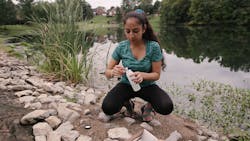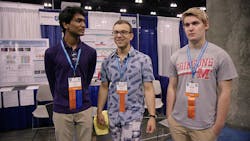Usually when I write about films, it’s about something like the technology in the Martian or how the visual effects are done in movies such as The War for the Planet of the Apes. This time it’s about National Geographic’s Science Fair and the reason is a little different.
I’ve been writing about science and robotic competitions for many years, encouraging you to get involved. I usually get an article or two in a year talking about the opportunities for students and why they need scientists and engineers to help judge. These tend to be a little dry compared to a movie, so I’m glad to be able to tell you about Science Fair, the movie. It takes a look at a group of students who were involved with the annual Intel International Science and Engineering Fair (ISEF). Check out the trailer:
I highly recommend it. Science Fair was the winner of the audience award at Sundance and SXSW, so don’t just take my word for it.
The film is directed by Cristina Costantini and Darren Foster, who also wrote and produced the film along with Jeffrey Plunkett. The directors’ previous film was “Death by Fentanyl,” a 2017 duPont Award-winning investigation about an opiate that's making the worst drug epidemic in U.S. history even deadlier.
Science Fair is certainly more upbeat than their earlier film. It tracks 10 out of more than 1700 students who participated in ISEF. That narrows the field a bit from the seven million students who took part in competitions that feed into ISEF. I help run the one in Mercer County, N.J., which has only a couple hundred students compete each year at the Mercer Science and Engineering Fair. Of those, only one or two make it to ISEF.
The film tracks half-a-dozen teams. Some were winners at ISEF and some were not, but all were enthusiastic. The coverage definitely gives the feel for the competition, although it’s tough to highlight all of the work that the students put into their projects.
1. Anjali, who attends high school in Louisville, developed an arsenic testing device that could save millions.
For example, Anjali (Fig. 1) is a student who attends Louisville high school. She scored a perfect 36 on her ACTs as a 13-year-old freshman. Now, as a sophomore, she developed an arsenic testing device that could save millions of lives. It might seem that getting to ISEF would be easy, but there’s more to this story.
ISEF is open to teams as well as individuals. One of the teams highlighted in the film is from Kentucky’s top science and engineering high school. Ryan, Harsha, and Abraham worked together to build a 3D-printed, electronic stethoscope that automatically connects to an online database of heart sounds (Fig. 2). This would allow doctors to diagnose heart abnormalities far more easily and accurately. They hope their stethoscope program would be useful in the developing world, where medics are understaffed and under-resourced.
2. Ryan, Harsha, and Abraham built a 3D-printed, electronic stethoscope that automatically connects to an online database of heart sounds.
These science competitions can have a significant effect on students. My three children are all gainfully employed engineers who competed in the local fair, and some when on to ISEF. My wife and I have been working with the fair for almost 20 years. It’s very rewarding and well worth the effort. Hopefully the film will inspire both students and adults.
There are actually quite a few competitions annually, but ISEF is the Super Bowl of science competitions for high-school students. The results of the competition alone are impressive from the number and quality of projects to the number of patents and real-world products and projects that emerge from the competition. The number may seem impressive, but compared to the money and effort put into sports competitions, it tends to be small. Still, the more people who become aware of the competition and its results, the better.
See Science Fair if you have the opportunity. It’s in theaters now and will likely be on cable in the future.
About the Author
William G. Wong
Senior Content Director - Electronic Design and Microwaves & RF
I am Editor of Electronic Design focusing on embedded, software, and systems. As Senior Content Director, I also manage Microwaves & RF and I work with a great team of editors to provide engineers, programmers, developers and technical managers with interesting and useful articles and videos on a regular basis. Check out our free newsletters to see the latest content.
You can send press releases for new products for possible coverage on the website. I am also interested in receiving contributed articles for publishing on our website. Use our template and send to me along with a signed release form.
Check out my blog, AltEmbedded on Electronic Design, as well as his latest articles on this site that are listed below.
You can visit my social media via these links:
- AltEmbedded on Electronic Design
- Bill Wong on Facebook
- @AltEmbedded on Twitter
- Bill Wong on LinkedIn
I earned a Bachelor of Electrical Engineering at the Georgia Institute of Technology and a Masters in Computer Science from Rutgers University. I still do a bit of programming using everything from C and C++ to Rust and Ada/SPARK. I do a bit of PHP programming for Drupal websites. I have posted a few Drupal modules.
I still get a hand on software and electronic hardware. Some of this can be found on our Kit Close-Up video series. You can also see me on many of our TechXchange Talk videos. I am interested in a range of projects from robotics to artificial intelligence.




